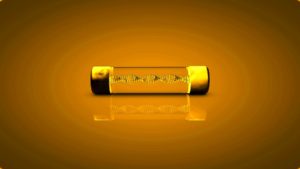What is a fuse?
Let’s start with the introduction of the topic ” what is a fuse”.
Fuses is current interrupting devices connected in series with the circuits to break or open the circuits by the fusing element when the current in the circuits exceeds a particular value which is called the safe value of the fuse then the fuse will melt and interrupt the circuit or break the circuit and protect our connected devices from damage.

Fuses are the simplest and cheapest devices used for interruption of an electrical circuit under short circuit conditions or when excessive current flows in the circuit.
A fuse consists of a fusible element in the form of a metal conductor of a specially selected small cross-section area, a case or cartridge to hold the fusible element, and provided with a means to aid arc extinction in some cases.
Fuses are always inserted in live wires and never connected in the neutral wire. The function of the fuse is to detect the fault as well as to interrupt the fault.
How does a fuse work
Fuse works on the heating effect of electric current. During normal operating conditions when the current flowing through the circuits is within safe limits then the heat developed in the fuse element carrying this current is readily dissipated in the surroundings and in this way fuse elements remain at a temperature below their melting point.
When a fault occurs, such as a short circuit or when the load connected in a circuit exceeds its capacity, then the value of the current in the circuit exceeds its limiting value,
Then the heat generated due to this excessive current is not dissipated quickly enough and the fuse element gets heated, melts, and interrupts the circuit.
In this way, a fuse protects a machine or apparatus, or installation from damage due to the excessive current.
The time for blowing out of the fuse depends on the magnitude of the excessive current. i.e the larger the value of the current more rapidly the fuse will blow.
This indicates that the fuse has an inverse time-current characteristic which is considered a good characteristic for protective gear for overload protection.

Characteristics of a Fuse
Fuse Wire or Fuse Element
Fuse wire is that part of the fuse which actually melts when an excessive current flows in the circuit and isolates the faulty device from the supply circuit. fuse wire is generally made up of alloys of lead and tin due to its low melting point.
Current Rating
It is defined as the RMS value of the current that a fuse can carry without breakdown and overheating within specified limits.
Fusing Current
Fusing current is the minimum value of current at which fuse wire or fuse element melts.
The fusing current will always be greater than the current rating of the fuse.
Fusing Factor
It is defined as the ratio of fusing current to that of the current rating of the fusing element. The fusing factor is always greater than 1.
Pre-arching time or Melting time
It is the time between the occurrence of a fault and when the cutoff occurs. It is generally 0.011sec.
Fuse Law
Fuse law explains the current carrying capacity of a fuse element.
According to fuse law for around wire, the approximate value of fusing current is given by
I = Kd3/2
Or, I2=d3
Where “d” is the diameter of the wire,”k” is a constant called the fuse constant.
Advantages of fuses
- Fuses are the cheapest form of protection.
- The operation of fuses is inherently completely automatic.
- It can interrupt enormous short circuit currents without noise, flame, gas, or smoke.
- It requires no maintenance.
- The minimum time of operation can be made much smaller than that with the circuit breaker.
- Fuse has an inverse time-current characteristic which enables its use for overload protection.
- The smaller size of the fuse element imposes a current limiting effect under short circuit conditions.
Disadvantages of fuses
- It requires replacement after every operation.
- On heavy short circuits, discrimination between fuses in series cannot be obtained unless there is a considerable difference in the relative sizes of the fuses concerned.
- The current-time characteristic of a fuse cannot always be correlated with that of the protected device.
I hope you like this article on “what is a fuse”. Comment below for more topics (other than what is a fuse) related to electrical engineering.
